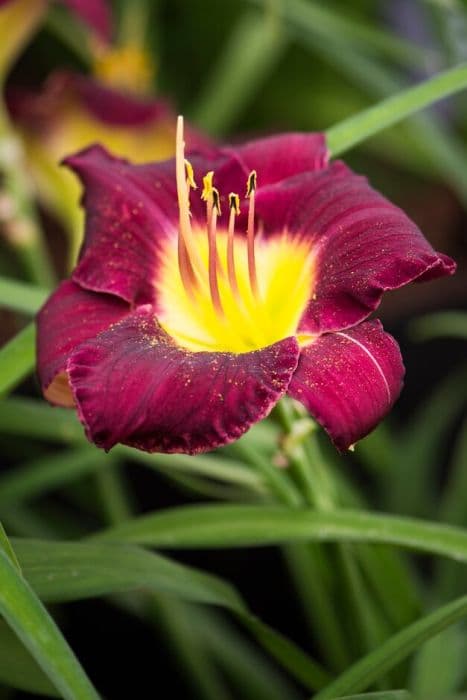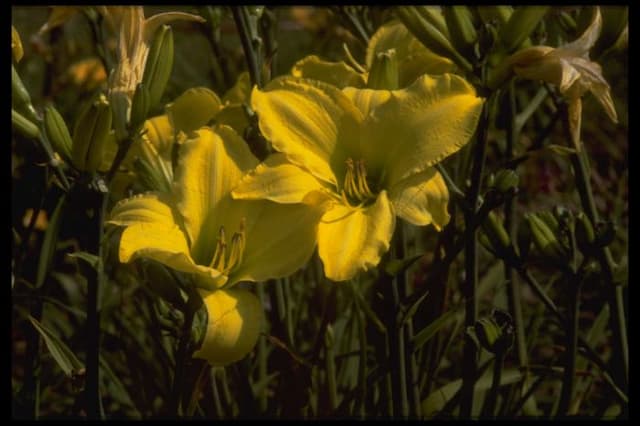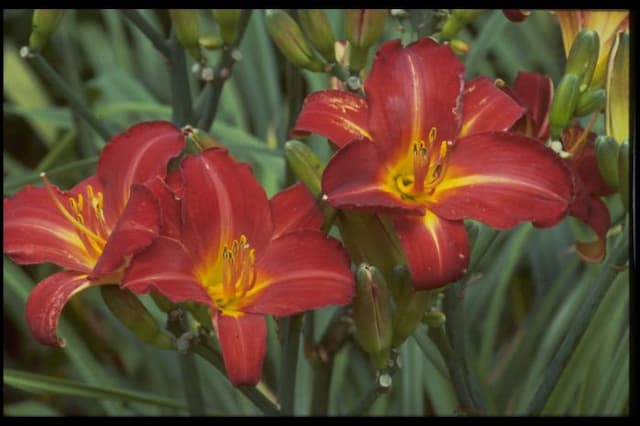New Zealand Flax Phormium cookianum subsp. hookeri 'Tricolor' (v)

ABOUT
The plant known as 'Tricolor' New Zealand Flax has a distinctive and striking appearance. It features long, sword-like leaves that boast a vibrant array of colors. Each leaf typically carries a combination of green, cream, and soft pinkish-red stripes that run lengthwise, creating an overall variegated look. This pattern infuses the plant with an eye-catching contrast, making it a popular choice for adding color to garden landscapes. The foliage has a slightly arching growth habit, adding dynamic movement to its form. Blooms may appear on the plant, rising above the foliage on tall spikes, but it is primarily grown for the beauty of its colorful leaves, which are the centerpiece of its ornamental appeal.
About this plant
 Names
NamesFamily
Asphodelaceae
Synonyms
New Zealand Flax, Harakeke, Mountain Flax, Wharariki
Common names
Phormium colensoi var. tricolor, Phormium hookeri, Phormium tenax var. hookeri.
 Toxicity
ToxicityTo humans
The plant commonly known as New Zealand Flax is generally not considered toxic to humans. There is no widespread documentation or reports of significant toxicity following ingestion of this plant by humans. However, as with any plant, sensitivity or allergic reactions are possible in some individuals. If any part of the plant is ingested and symptoms do appear, it is recommended to seek medical advice.
To pets
New Zealand Flax is not typically listed as a toxic plant to pets such as cats and dogs. While it is unlikely to cause serious poisoning, ingestion can potentially cause mild gastrointestinal upset in some animals due to the fibrous nature of the plant material. If your pet shows signs of illness after consuming parts of this plant, consult your veterinarian for appropriate care.
 Characteristics
CharacteristicsLife cycle
Perennials
Foliage type
Evergreen
Color of leaves
Mixed
Flower color
Varies
Height
4 feet (1.2 meters)
Spread
3 feet (0.9 meters)
Plant type
Shrub
Hardiness zones
8
Native area
New Zealand
Benefits
 General Benefits
General Benefits- Ornamental Appeal: The 'Tricolor' variety adds vibrant color and textural contrast to gardens with its variegated green, cream, and pinkish-red leaves.
- Drought Tolerance: Well-suited for xeriscaping due to its ability to withstand periods of drought once established.
- Low Maintenance: Requires minimal care, occasional pruning, and is relatively pest-free, simplifying garden upkeep.
- Coastal Tolerance: Adapted to coastal conditions, including salt spray and sandy soils, making it ideal for seaside landscapes.
- Architectural Structure: Provides year-round architectural interest with its upright, sword-like foliage, ideal for modern garden design.
- Erosion Control: Its robust root system helps to stabilize slopes and banks, reducing soil erosion.
- Cold Hardiness: Capable of withstanding cooler temperatures, making it suitable for a range of climatic conditions.
- Wildlife Support: Can serve as habitat and provide shelter for various insects and small wildlife.
 Medical Properties
Medical PropertiesThis plant is not used for medical purposes.
 Air-purifying Qualities
Air-purifying QualitiesThis plant is not specifically known for air purifying qualities.
 Other Uses
Other Uses- Decorative Arts: The striking leaves of New Zealand Flax can be used in floral arrangements for a bold and dramatic effect.
- Fiber Production: The plant's strong, strappy leaves can be processed to extract fibers for making traditional Maori textiles and crafts.
- Gardening Mulch: Dried leaves can be used as a visually appealing and functional mulch in gardens to retain soil moisture and suppress weeds.
- Erosion Control: New Zealand Flax can be planted on slopes and banks to help stabilize soil and prevent erosion due to its robust root system.
- Habitat Creation: Planting New Zealand Flax in gardens can provide shelter and nesting materials for birds, as well as attract beneficial insects.
- Windbreak: The dense growth habit of New Zealand Flax makes it an effective windbreak, protecting more delicate plants and reducing wind erosion.
- Livestock Feed: In times of scarcity, the leaves may be used as fodder, though it is not a common or general practice due to their toughness.
- Tannin Extraction: The roots of New Zealand Flax can be used for extracting tannin, which can be used in leather production.
- Fish Traps: In traditional uses, the fibrous leaves can be woven into fish traps and eel pots, a practice common among indigenous Maori people.
- Thatching: The long, durable leaves can be utilized for thatching roofs in traditional building techniques.
Interesting Facts
 Feng Shui
Feng ShuiNew Zealand Flax is not used in Feng Shui practice.
 Zodiac Sign Compitability
Zodiac Sign CompitabilityNew Zealand Flax is not used in astrology practice.
 Plant Symbolism
Plant Symbolism- Resilience: The Phormium cookianum, also known as New Zealand Flax, is known for its tough, fibrous leaves, symbolizing the ability to withstand tough conditions.
- Versatility: Given the various uses of New Zealand Flax in traditional Maori culture, from textiles to medicine, it represents adaptability and resourcefulness.
- Beauty: The 'Tricolor' variety, with its striking green, cream, and pinkish leaves, showcases the aesthetic beauty that can be found in nature, symbolizing appreciation for beauty in all its forms.
 Water
WaterNew Zealand Flax prefers evenly moist soil, so it is important to water it regularly but not excessively. During the growing season, water the plant once a week with about 1 gallon of water per session for a medium-sized plant. In the hot summer months, the frequency may need to increase to twice a week if the weather is particularly dry. During the winter, reduce watering to every two weeks or when the soil feels dry to the touch. Always allow the top inch of soil to dry out before watering again to prevent root rot.
 Light
LightNew Zealand Flax thrives best in full sun to partial shade. It can tolerate a wide range of lighting conditions, but for the best foliage color, place it in a spot where it receives at least 6 hours of direct sunlight each day. Avoid deep shade, as this can cause the leaves to lose their vibrant colors.
 Temperature
TemperatureNew Zealand Flax can tolerate a wide range of temperatures, from as low as 20°F to highs around 80°F. However, its ideal growing conditions are within 65°F to 75°F. Always provide some protection from extreme cold or frost, as prolonged exposure to temperatures below 20°F may damage the plant.
 Pruning
PruningPrune New Zealand Flax to remove any damaged or dead leaves and to maintain its shape. This should be done in the spring or early summer, which is the best time for pruning to promote new growth. Cut the leaves at the base near the soil line. Pruning may not be required annually but monitor the plant's appearance and health to determine the need for maintenance.
 Cleaning
CleaningAs needed
 Soil
SoilThe New Zealand Flax 'Tricolor' thrives best in a well-draining soil mix with a pH range of 5.5 to 6.5. A mixture of two parts loam, one part peat, and one part sand is often recommended to provide adequate drainage and aeration. Regularly check soil moisture to avoid waterlogging.
 Repotting
RepottingNew Zealand Flax 'Tricolor' should generally be repotted every two to three years to refresh the soil and accommodate root growth. It's best to repot in spring before the growing season starts, ensuring minimum stress to the plant.
 Humidity & Misting
Humidity & MistingNew Zealand Flax 'Tricolor' is fairly tolerant of different humidity levels but prefers moderate to high humidity if possible. However, it will typically adapt to the average household humidity without issue, making it quite versatile.
 Suitable locations
Suitable locationsIndoor
Provide bright indirect light and avoid overwatering.
Outdoor
Full sun to partial shade, protect from harsh winds.
Hardiness zone
8-11 USDA
 Life cycle
Life cyclePhormium cookianum subsp. hookeri 'Tricolor' (v), also known as 'Tricolor' New Zealand Flax, begins its life as a seed, which germinates in warm, moist soil conditions. Upon germination, a seedling emerges and develops into a young plant with linear, sword-shaped leaves that display a variegated pattern of green, cream, and pink stripes. As the plant matures, it forms a clump of evergreen foliage, continuously producing new leaves from its base while older leaves at the outer edges may die back. 'Tricolor' New Zealand Flax may produce inflorescences on long, arching stalks adorned with tubular flowers, which in turn can attract birds and insects, although flowering is not as common in cultivation for this ornamental variety. Following pollination, seed capsules may develop, containing seeds that can be dispersed to complete the reproductive cycle. The plant continues to grow and expand, potentially lasting for many years, and can be propagated vegetatively by dividing the clumps to rejuvenate and spread the plant.
 Propogation
PropogationPropogation time
Spring-Early Summer
New Zealand Flax 'Tricolor', the cultivar of Phormium cookianum subsp. hookeri, can be propagated most effectively by division. The ideal time to carry out this process is in the spring, just as the plant begins to show new growth. To propagate by division, carefully dig up the parent plant and use a sharp knife or spade to divide the root clump into sections, ensuring that each section has at least one growing point or fan of leaves. These divisions can then be replanted into well-draining soil, at the same depth they were growing previously, and watered in to establish. New Zealand Flax prefers a sunny position but will also tolerate partial shade, which should be considered when choosing a site for the newly divided plants. It is important to provide regular water until the new plants are fully established but be careful not to overwater as this can lead to root rot.









